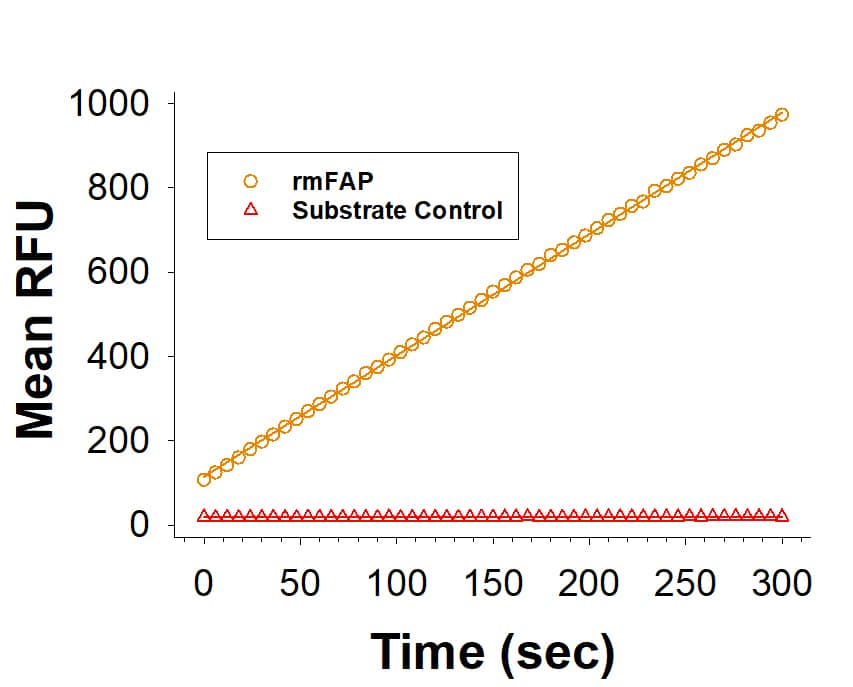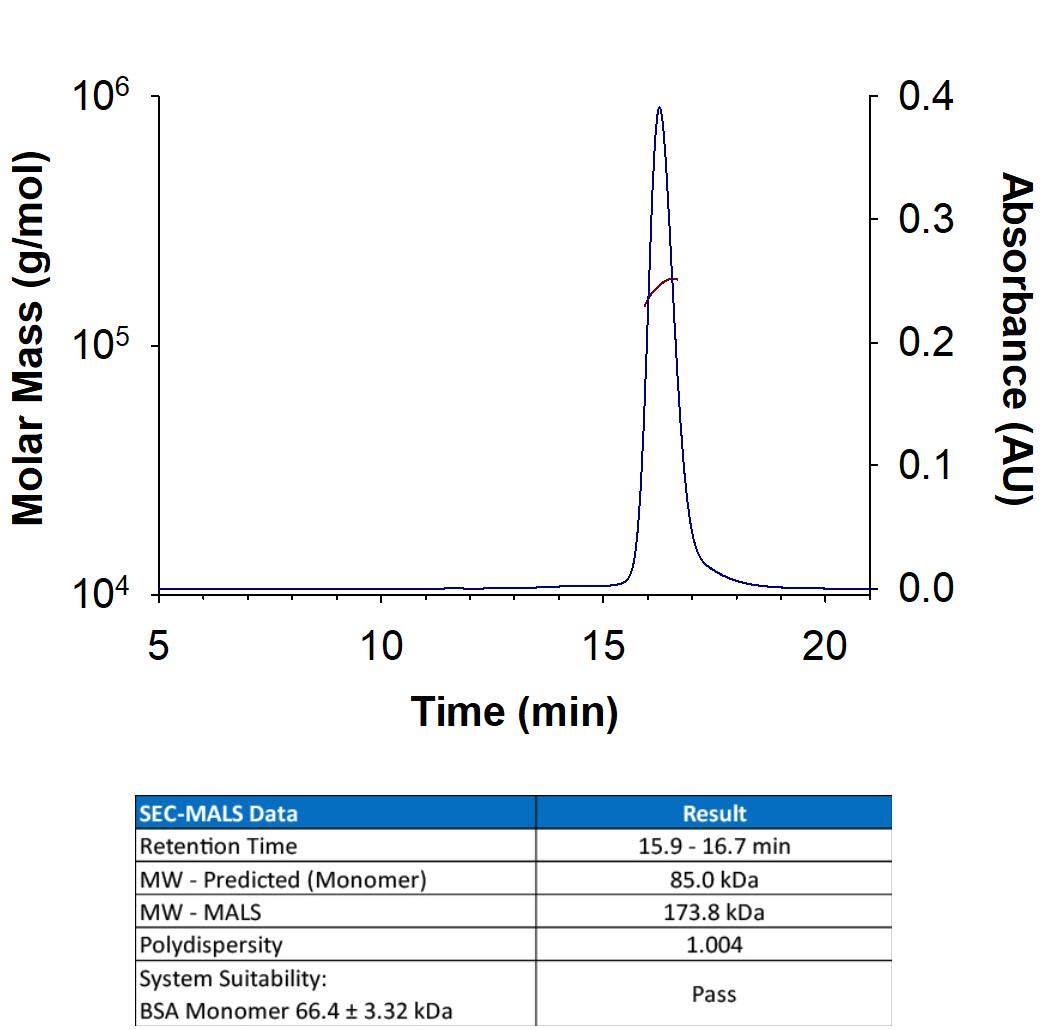Recombinant Mouse FAP Protein, CF
R&D Systems, part of Bio-Techne | Catalog # 8647-SE
Analyzed by SEC-MALS

Key Product Details
Product Specifications
Source
Mouse myeloma cell line, NS0-derived mouse Fibroblast Activation Protein alpha/FAP protein
Leu26-Asp761
Leu26-Asp761
Purity
>95%, by SDS-PAGE visualized with Silver Staining and quantitative densitometry by Coomassie® Blue Staining.
Endotoxin Level
<1.0 EU per 1 μg of the protein by the LAL method.
N-terminal Sequence Analysis
Leu26 & Val31
Predicted Molecular Mass
85 kDa
SDS-PAGE
78-90 kDa, reducing conditions
Activity
Measured by its ability to convert the substrate benzyloxycarbonyl-Gly-Pro-7-amido-4-methylcoumarin (Z-GP-AMC) to Z-Gly-Pro and 7-amino-4-methylcoumarin (AMC).
The specific activity is >2000 pmol/min/μg, as measured under the described conditions.
The specific activity is >2000 pmol/min/μg, as measured under the described conditions.
Scientific Data Images for Recombinant Mouse FAP Protein, CF
Recombinant Mouse Fibroblast Activation Protein alpha/FAP Protein SEC-MALS.
Recombinant Mouse FAP (Catalog # 8647-SE) has a molecular weight (MW) of 173.8 kDa as analyzed by SEC-MALS, suggesting that this protein is a homodimer. MW may differ from predicted MW due to post-translational modifications (PTMs) present (i.e. Glycosylation).Recombinant Mouse FAP Protein Enzyme Activity
Recombinant Mouse FAP (Catalog # 8647-SE) is measured by its ability to convert the substrate benzyloxycarbonyl-Gly-Pro-7-amido-4-methylcoumarin (Z-GP-AMC) to Z-Gly-Pro and 7-amino-4-methylcoumarin (AMC).Formulation, Preparation and Storage
8647-SE
| Formulation | Supplied as a 0.2 μm filtered solution in Tris, NaCl and Glycerol. |
| Shipping | The product is shipped with polar packs. Upon receipt, store it immediately at the temperature recommended below. |
| Stability & Storage | Use a manual defrost freezer and avoid repeated freeze-thaw cycles.
|
Background: Fibroblast Activation Protein alpha/FAP
References
- Zi, F. et al. (2015) Mol. Med. Rep. 11:3203.
- Pineiro-Sanchez, M.L. et al. (1997) J. Biol. Chem. 272:7595.
- Niedermeyer, J. et al. (1997) Int. J. Cancer 71:383.
- Scanlan, M.J. et al. (1994) Proc. Natl. Acad. Sci. USA 91:5657.
- Park, J.E. et al. (1999) J. Biol. Chem. 274:36505.
- Rettig, W.J. et al. (1988) Proc. Natl. Acad. Sci. USA 85:3110.
- Bauer, S. et al. (2006) Arthritis Res. 8:R171.
- Aertgeerts, K. et al. (2005) J. Biol. Chem. 280:19441.
- Keane, F.M. et al. (2011) FEBS J. 278:1316.
- Ghersi, G. et al. (2006) Cancer Res. 66:4652.
- Ghersi, G. et al. (2002) J. Biol. Chem. 277:29231.
- Cheng, J.D. et al. (2005) Mol. Cancer Ther. 4:351.
- Cheng, J.D. et al. (2002) Cancer Res. 62:4767.
- Kraman, M. et al. (2010) Science 330:827.
Alternate Names
FAP, Seprase
Gene Symbol
FAP
UniProt
Additional Fibroblast Activation Protein alpha/FAP Products
- All Products for Fibroblast Activation Protein alpha/FAP
- Fibroblast Activation Protein alpha/FAP cDNA Clones
- Fibroblast Activation Protein alpha/FAP ELISA Kits
- Fibroblast Activation Protein alpha/FAP Lysates
- Fibroblast Activation Protein alpha/FAP Primary Antibodies
- Fibroblast Activation Protein alpha/FAP Proteins and Enzymes
- Fibroblast Activation Protein alpha/FAP Simple Plex
Product Documents for Recombinant Mouse FAP Protein, CF
Product Specific Notices for Recombinant Mouse FAP Protein, CF
For research use only
